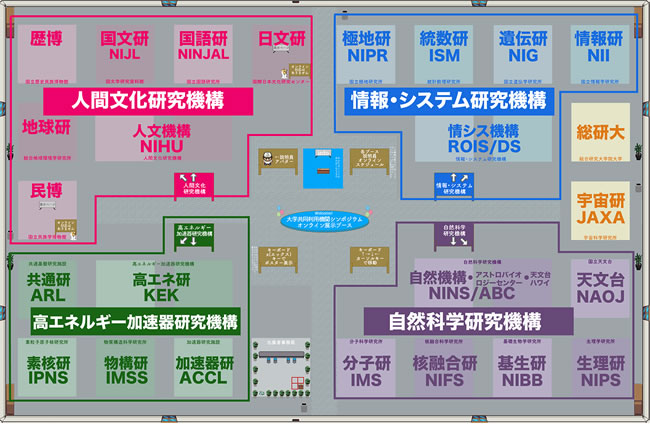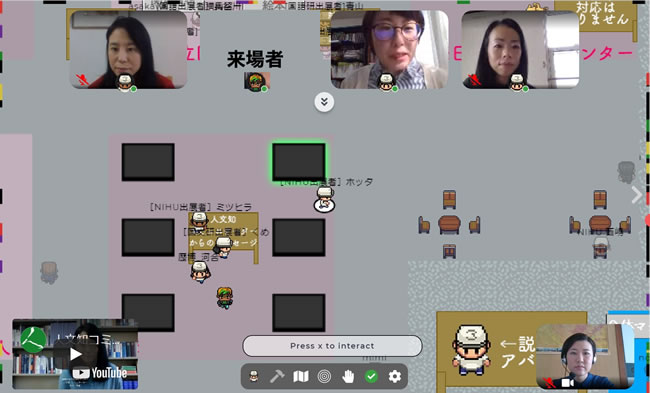No.055 - NIHU from home: A new guise of conferences and exhibitions in a time of pandemic
NIHU from home: A new guise of conferences and exhibitions in a time of pandemic
With the onset of the coronavirus pandemic, people have had to refrain from parties, karaoke singing, and other social gatherings we long took for granted, and in so many ways we are now exploring new modes of living, working, and socializing. The same is true when holding lecture meetings attended by large numbers of people and exhibitions where visitors mingle. Responding to this situation, the annual symposium jointly held by the inter-university research institutes took place online for the first time on October 17 and 18, 2020.
The highlight of the first day of the event was presentations by scholars reporting on the latest results of their research. Three researchers from the National Institutes for the Humanities(NIHU)gave a talk. First, Robert Campbell, vice-president of NIHU and director-general of the National Institute of Japanese Literature, talked about NIHU, discussing features of the six institutes under the NIHU umbrella as well as projects handled directly by the NIHU head office. Next was Tetsuzo Yasunari, director-general of the Research Institute for Humanity and Nature, who spoke about “COVID-19 and Climate Change: Toward Simultaneous Solution of the Two Problems through the Green Recovery.” Global warming is caused by greenhouse gas emissions, he said, and future climatic conditions of the earth will depend on what options we pursue from now on. He then referred to the latest research findings that show that the amount of Carbon Dioxide(CO2)emissions from January up to the end of April 2020 was on the decrease worldwide as the result of people staying home and being restricted to travel, a constraint imposed by the COVID-19 pandemic. What those findings indicate, he stressed, is that we can reduce greenhouse emissions if we really try.
As the third NIHU presenter, Michifumi Isoda, associate professor of the International Research Center for Japanese Studies, spoke on the theme of “Epidemics in Japanese History.” According to him, the oldest epidemic ever recorded in Japan occurred in “the fifth year of the reign of Emperor Sujin” as depicted in the Nihon shoki(Chronicles of Japan). Records from the influenza pandemic that hit the world in 1918–1920 offer many lessons from which we can learn in the face of the current coronavirus pandemic, he said. From them we can infer, for instance, that politicians at such a time are likely to lift restrictions on gatherings early. Reading of official records, people’s diaries, and other primary sources that record the situation of such times is crucial, he declared, for learning such lessons.
The highlight of the second day was an interactive exhibition, also held online. The visitors and exhibitors were represented by avatars who entered the online exhibition site where the 21 inter-university research institutes had organized various exhibits. Via their avatars, visitors could move about freely and, by turning on their computer’s camera and microphone, talk with other visitors or exhibitors online. At the NIHU head office’s online exhibition space, a video was shown introducing the activities of the “liberal arts communicators.” The liberal arts communicators are those who undergo special training at NIHU and are assigned to the six research institutes under the NIHU umbrella. To facilitate interaction with visitors, there were several sessions in which the visitors could enjoy talking with the liberal arts communicators or NIHU staff in real time online.
According to Masaru Kiretsugawa, director-general of the National Institute of Informatics, the event received some 2,000 registrations in advance and registered participants were not only from various parts of Japan but from overseas as well. The pandemic prevented the symposium and exhibits from being held in the same format as the previous ones, but the online format enabled people to participate from home, regardless of where they lived.

Online exhibition spaces. Visitors and exhibitors alike enter the exhibition site in the guise of avatars. Online visitors could view the exhibits on display and communicate with the exhibitors in real time.

Liberal arts communicators communicating with visitors online by audio and/or visual means.
(Text: Ayumi Koso)
Related links
Exhibits(online)
National Institutes for the Humanities(NIHU)headquarters exhibition “Toward a New Value System for the Humanities”
National Museum of Japanese History(Rekihaku)exhibition “Rekihaku Digital Historical Resources”
National Institute of Japanese Literature(NIJL)exhibition “Getting to Know the Japanese Classics”
National Institute for Japanese Language and Linguistics(NINJAL)’s exhibition “Learning Linguistics at Home: Language Is Fascinating!”
(1)Karuta card game, dictionaries, and picture books
(2)Learning Japanese for beginners
(3)Video materials for undergraduate and graduate students
International Research Center for Japanese Studies(Nichibunken)exhibition “Okoshiyasu [Welcome] to Nichibunken”
Research Institute for Humanity and Nature(Chikyuken)exhibition “Come and Look at Chikyuken”
National Museum of Ethnology(Minpaku)exhibition “Minpaku Virtual Museum”
